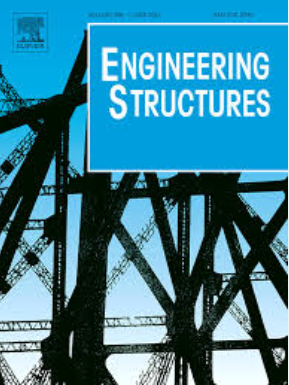评价细部结构对斜向配筋耦合梁抗震性能的影响
IF 6.4
1区 工程技术
Q1 ENGINEERING, CIVIL
引用次数: 0
摘要
斜向配筋耦合梁在地震作用下对钢筋混凝土核心墙的耗能和延性起着至关重要的作用。本研究评估了drcb的循环响应,并检查了美国和加拿大设计规范的潜在限制。编制了51个试验试验的数据库,以评估嵌入式纵杆(ELB)、轴向约束(AR)和约束细节对力-变形行为的影响。结果表明,带有AR或ELB的试件表现出明显的超强度,这可以通过截面分析来估计,并在计算中考虑纵向杆的挠曲贡献。无AR或ELB的DRCBs的中位过强约为1.25;然而,AR或ELB的存在可以使剪切力进一步增加30%至40%。低斜筋的试件也表现出旋转能力的降低。基于这些发现,提出了一个新的力设计极限,并建议抗震规范为低纵横比耦合梁引入更低的旋转极限,以更好地反映观测到的性能。本文章由计算机程序翻译,如有差异,请以英文原文为准。
Evaluating the influence of detailing on the seismic performance of diagonally reinforced coupling beams
Diagonally reinforced coupling beams (DRCBs) play a critical role in energy dissipation and ductility in reinforced concrete core walls subjected to seismic forces. This study evaluates the cyclic response of DRCBs and examines potential limitations in US and Canadian design codes. A database of 51 experimental tests is compiled to assess the influence of embedded longitudinal bars (ELB), axial restraints (AR), and confinement details on force-deformation behavior. Results indicate that specimens with AR or ELB exhibit significant overstrength, which can be estimated using sectional analysis and incorporating the flexural contribution of longitudinal bars in calculations. DRCBs without AR or ELB had a median overstrength around 1.25; however, the presence of AR or ELB can increase shear forces by a further 30 to 40 percent. Specimens with low diagonal reinforcement also demonstrated reduced rotational capacity. Based on these findings, a new force design limit is proposed, and it is recommended that seismic codes introduce lower rotational limits for low-aspect ratio coupling beams to better reflect observed performance.
求助全文
通过发布文献求助,成功后即可免费获取论文全文。
去求助
来源期刊

Engineering Structures
工程技术-工程:土木
CiteScore
10.20
自引率
14.50%
发文量
1385
审稿时长
67 days
期刊介绍:
Engineering Structures provides a forum for a broad blend of scientific and technical papers to reflect the evolving needs of the structural engineering and structural mechanics communities. Particularly welcome are contributions dealing with applications of structural engineering and mechanics principles in all areas of technology. The journal aspires to a broad and integrated coverage of the effects of dynamic loadings and of the modelling techniques whereby the structural response to these loadings may be computed.
The scope of Engineering Structures encompasses, but is not restricted to, the following areas: infrastructure engineering; earthquake engineering; structure-fluid-soil interaction; wind engineering; fire engineering; blast engineering; structural reliability/stability; life assessment/integrity; structural health monitoring; multi-hazard engineering; structural dynamics; optimization; expert systems; experimental modelling; performance-based design; multiscale analysis; value engineering.
Topics of interest include: tall buildings; innovative structures; environmentally responsive structures; bridges; stadiums; commercial and public buildings; transmission towers; television and telecommunication masts; foldable structures; cooling towers; plates and shells; suspension structures; protective structures; smart structures; nuclear reactors; dams; pressure vessels; pipelines; tunnels.
Engineering Structures also publishes review articles, short communications and discussions, book reviews, and a diary on international events related to any aspect of structural engineering.
 求助内容:
求助内容: 应助结果提醒方式:
应助结果提醒方式:


